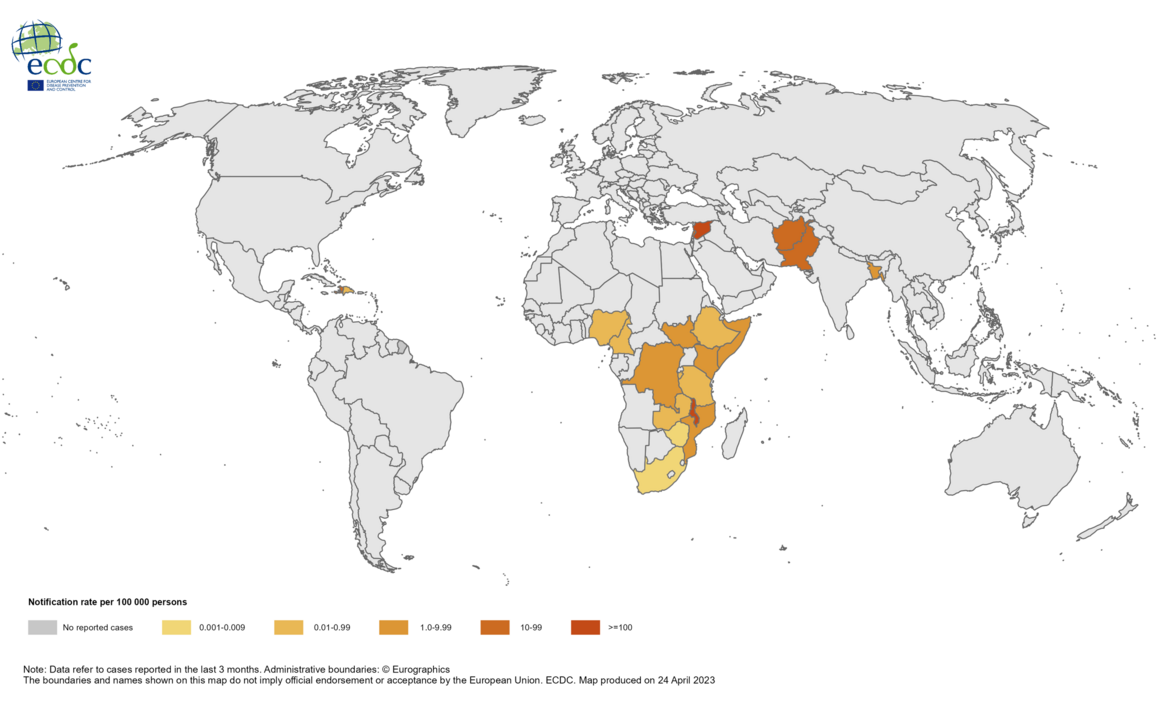Cholera worldwide overview
Monthly update as of 24 April 2023
ECDC monitors cholera outbreaks globally through epidemic intelligence activities in order to identify significant changes in epidemiology and to inform public health authorities. Reports are published on a monthly basis.
Since the last update on 23 March 2023 and as of 24 April 2023, 49 857 new cholera cases, including 298 new deaths, have been reported worldwide. The five countries reporting the greatest number of new cases are Pakistan, Bangladesh, Mozambique, Syria, and Malawi. The five countries reporting the greatest number of new deaths are Nigeria, Malawi, Mozambique, Haiti, and Kenya. In addition, 99 136 new cases were reported or collected retrospectively from before 23 March 2023.
Geographical distribution of cholera cases reported worldwide from February to April 2023

Asia:
Afghanistan: Since 25 February 2023 and as of 20 March 2023, 3 156 new cases have been reported. Since 1 January 2023 and as of 20 March 2023, 22 848 cases, including seven deaths have been reported. In comparison, since 1 January 2022 and as of 31 March 2022, 5 207 cases had been reported.
Bangladesh: Since 11 February 2023 and as of 8 April 2023, 18 150 new cases have been reported. Since 1 January 2023 and as of 8 April 2023, 34 060 cases have been reported. In comparison, since 1 January 2022 and as of 12 April 2022, 495 433 cases, including 29 deaths had been reported.
Lebanon: Since 14 March 2023 and as of 17 April 2023, 474 new cases have been reported. Since 1 January 2023 and as of 17 April 2023, 1 574 cases have been reported.
Pakistan: Since 1 January 2023 and as of 20 March 2023, 77 714 cases have been reported.
Syria: Since 15 February 2023 and as of 19 March 2023, 13 310 new cases, including three new deaths have been reported. Since 1 January 2023 and as of 19 March 2023, 53 080 cases, including seven deaths have been reported.
No updates have been reported by: India and the Philippines.
Africa:
Burundi: Since 13 March 2023 and as of 8 April 2023, 71 new cases have been reported. Since 1 January 2023 and as of 8 April 2023, 247 cases, including one death have been reported.
Cameroon: Since 5 March 2023 and as of 30 March 2023, 51 new cases have been reported. Since 1 January 2023 and as of 30 March 2023, 214 cases, including 10 deaths have been reported. In comparison, since 1 January 2022 and as of 27 March 2022, 2 886 cases, including 65 deaths had been reported.
Democratic Republic of the Congo: Since 10 March 2023 and as of 19 March 2023, 1 959 new cases, including eight new deaths have been reported. Since 1 January 2023 and as of 19 March 2023, 7 243 cases, including 47 deaths have been reported. In comparison, since 1 January 2022 and as of 17 April 2022, 5 131 cases, including 73 deaths had been reported.
Ethiopia: Since 12 March 2023 and as of 3 April 2023, 661 new cases, including 18 new deaths have been reported. Since 1 January 2023 and as of 3 April 2023, 1 616 cases, including 30 deaths have been reported. In comparison, since 1 January 2022 and as of 31 January 2022, 674 cases, including seven deaths had been reported.
Kenya: Since 6 March 2023 and as of 4 April 2023, 2 522 new cases, including 46 new deaths have been reported. Since 1 January 2023 and as of 4 April 2023, 5 243 cases, including 78 deaths have been reported.
Malawi: Since 16 March 2023 and as of 20 April 2023, 3 943 new cases, including 81 new deaths have been reported. Since 1 January 2023 and as of 20 April 2023, 40 615 cases, including 1 165 deaths have been reported. In comparison, since 1 January 2022 and as of 17 April 2022, 64 cases, including three deaths had been reported.
Mozambique: Since 12 March 2023 and as of 14 April 2023, 17 023 new cases, including 68 new deaths have been reported. Since 1 January 2023 and as of 14 April 2023, 23 105 cases, including 113 deaths have been reported. In comparison, since 1 January 2022 and as of 18 March 2022, 265 cases had been reported.
Nigeria: Since 28 February 2023 and as of 13 March 2023, 2 995 new cases, including 94 new deaths have been reported. Since 1 January 2023 and as of 13 March 2023, 3 667 cases, including 119 deaths have been reported. In comparison, since 1 January 2022 and as of 8 April 2022, 1 358 cases, including 31 deaths had been reported.
Somalia: Since 12 February 2023 and as of 1 April 2023, 2 725 new cases, including 14 new deaths have been reported. Since 1 January 2023 and as of 1 April 2023, 4 032 cases, including 15 deaths have been reported.
South Africa: Since 4 March 2023 and as of 6 April 2023, four new cases have been reported. Since 1 January 2023 and as of 6 April 2023, eight cases, including one death have been reported. In comparison, in 2022, no cases had been reported.
South Sudan: Since 12 March 2023 and as of 30 March 2023, 339 new cases, including one new death have been reported. Since 1 January 2023 and as of 30 March 2023, 608 cases, including two deaths have been reported.
Zambia: Since 12 March 2023 and as of 9 April 2023, 106 new cases, including three new deaths have been reported. Since 1 January 2023 and as of 9 April 2023, 331 cases, including eight deaths have been reported. In comparison, since 1 January 2022 and as of 13 April 2022, four cases had been reported.
Zimbabwe: Since 5 March 2023 and as of 27 March 2023, 259 new cases, including eight new deaths have been reported. Since 1 January 2023 and as of 27 March 2023, 317 cases, including eight deaths have been reported. In comparison, since 1 January 2022 and as of 27 January 2022, one case had been reported.
No updates have been reported by: Benin and Tanzania.
Americas:
Dominican Republic: Since 6 March 2023 and as of 16 March 2023, two new cases have been reported. Since 1 January 2023 and as of 16 March 2023, 91 cases have been reported.
Haiti: Since 9 March 2023 and as of 14 April 2023, 3 529 new cases, including 59 new deaths have been reported. Since 1 January 2023 and as of 14 April 2023, 18 426 cases, including 195 deaths have been reported.
ECDC assessment
Cholera cases continue to be reported in western Africa and south-east Asia over the past months. Cholera outbreaks have also been notified in the eastern and southern parts of Africa as well as in some parts of the Middle East. Despite the number of cholera outbreaks reported worldwide, few cases are reported each year among returning EU/EEA travellers. In this context, the risk of cholera infection in travellers visiting these countries remains low, even though sporadic importation of cases in the EU/EEA remains possible. In 2021, two cases were reported in EU/EEA Member States, while three and 26 cases were reported in 2020 and 2019 respectively. All cases had travel history to cholera-affected areas. According to the WHO, vaccination should be considered for travellers at higher risk, such as emergency and relief workers who are likely to be directly exposed to cholera.
Vaccination is generally not recommended for other travellers. Travellers to cholera-endemic areas should seek advice from travel health clinics to assess their personal risk and apply precautionary sanitary and hygiene measures to prevent infection. These can include drinking bottled water or water treated with chlorine, carefully washing fruits and vegetables with bottled or chlorinated water before consumption, regularly washing hands with soap, eating thoroughly cooked food, and avoiding the consumption of raw seafood products.
Actions
ECDC continues to monitor cholera outbreaks globally through its epidemic intelligence activities in order to identify significant changes in epidemiology, and to facilitate updates to public health authorities. Reports are published on a monthly basis. The worldwide overview of cholera outbreaks is available on ECDC's website.
Disclaimer: Data presented in this report originate from several sources, both official public health authorities and non-official, such as the media. Data completeness depends on the availability of reports from surveillance systems and their accuracy, which varies between countries. All data should be interpreted with caution as there may be areas of under-reporting and figures may not reflect the actual epidemiological situation.





